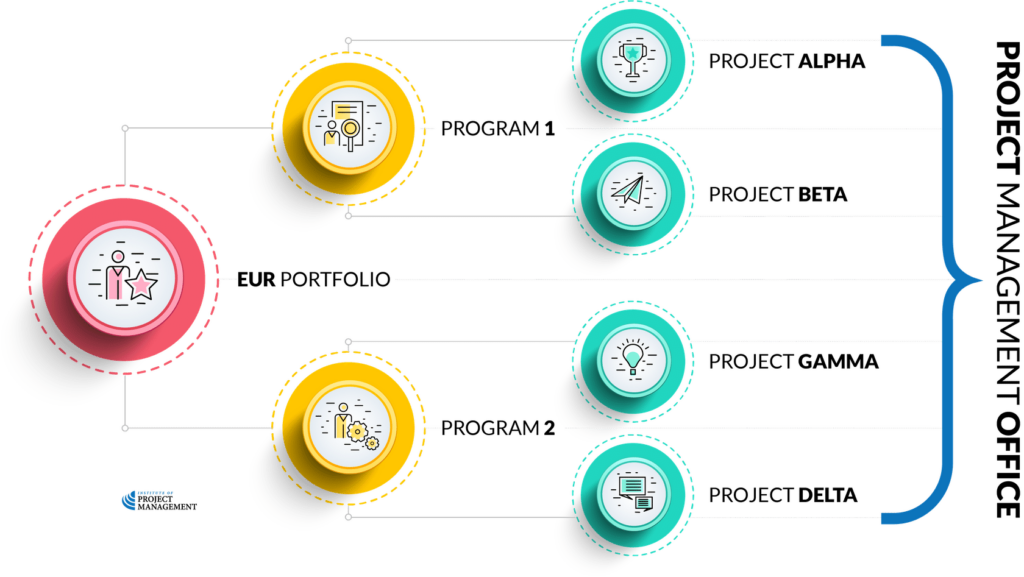1.4 The projectised organisation and PMO
All projects great and small
Twenty-first-century organizations are becoming increasingly ‘projectized‘ in delivering their work.
Whereas once upon a time, projects were conducted separately from business as usual, today, they are just as likely to be performed by administrative and custodial teams as they are by an enterprise’s cutting-edge research and development arms.
Authors such as Erik Larson have long argued that the hidden challenge for organizations is managing the hundreds or even thousands of concurrently delivered projects that are sharing (and stretching) resources beyond the point of efficiency.
In fact, it is a rare business that can quickly and accurately list the number and value of every project that it has under some form of management, especially when you include all the micro-projects that fly beneath the radar.
Because these smaller projects are perceived to carry less operational, financial, and reputational risk, their performance is imperfectly measured – if it is measured at all.
Yet when taken in total, they are actually consuming huge amounts of time, money, and brain-power, typically at the expense of other activities (and even each other).
For that reason, systems and processes that support holistic project delivery – from concept through to outcome realization – are essential if organizations are to continue to innovate.
It also means that project management should no longer be an elite managerial skill set.
Every employee, contractor, and volunteer needs to be equipped to support the performance and delivery of projects.
Next, we will look at how projects are typically organized.

Projects, programs, and portfolios
A group of related projects is often organized as a program of work.
Portfolio is the name we give to a collection of often unrelated programs.
In other words, all the projects of your IT department might be one program; whereas the projects of your manufacturing arm might be split into three or four different programs.
Every project your organisation does would collectively be referred to as its portfolio; although, you could conceivably have multiple portfolios organised by geography or other circumstance.
For example, the International Olympic Committee could be said to have a single portfolio of sports events, or multiple portfolios that are distinguished by event, such as the Summer Olympic Games, Winter Olympic Games, Special Olympics and so forth.
Each Olympic variant will have multiple programs based on the different sports, such as track and field, swimming, cycling, and the like.
Track and field would then have a number of projects that need to be delivered, such as the men’s discus, the women’s heptathlon, the marathon, etc.
So when does a project end, a program start, and a portfolio take over?

Project management office (PMO)
Where a project ends, a program starts and a portfolio takes over is a structural decision for each organization.
It will depend on the intended outcomes and the efficiencies that can be gained.
Mature organizations delivering multiple projects – what we call projectized organizations – inevitably rely on a distinct business unit in this regard called their Project Management Office.
A Project Management Office (PMO) is a group or department that defines and maintains standards for project management within an organization.
PMO responsibilities can range from merely providing project management support functions to being responsible for directly managing one or more projects.
They ultimately assist you, the project manager, in a number of ways, including:
- Identifying and developing project management methods, best practices, and standards
- Developing project tools, templates, and other shared documentation
- Managing shared resources across a number of projects, including staff and materials
- Coaching, mentoring, and training project teams
- Monitoring compliance with standards through project audits, and
- Coordinating communication across projects and with the rest of the organization.
A PMO is ultimately an organization’s single source of project intelligence and truth.
Historically, PMOs have been a sub-department of a business unit that delivers a lot of projects, such as a capital works or assets team.
However, more and more organizations are adopting enterprise-wide PMOs known as EPMOs.
EPMOs recognize that for every high-profile project being delivered, countless ‘hidden’ projects are going on.
They, therefore, leverage the benefits of a consistently applied project methodology across all organizational and project stakeholders.
Now not every organisation has a PMO, but seriously, nearly every one should. In smaller organisations, a PMO could even be a single person with expertise in project management sharing their skills across the business for the benefit of all.
For as we have already stated (and as you will see through this course), projects are not the same as business as usual. They demand a unique skill set if they are to be efficiently and effectively delivered.
